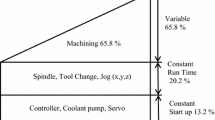Abstract
In machining, coolants improve machinability, increase productivity by reducing tool wear and extend tool life. However, due to ecological and human health problems, manufacturing industries are now being forced to implement strategies to reduce the amount of cutting fluids used in their production lines. A trend that has emerged to solve these problems is machining without fluid – a method called dry machining – which has been made possible due to technological innovations. This paper presents an experimental investigation of the influence of tool geometry (radial rake angle and nose radius) and cutting conditions (cutting speed and feed rate) on machining performance in dry milling with four fluted solid TiAlN-coated carbide end mill cutters based on Taguchi’s experimental design method. The mathematical model, in terms of machining parameters, was developed for surface roughness prediction using response surface methodology. The optimization is then carried out with genetic algorithms using the surface roughness model developed and validated in this work. This methodology helps to determine the best possible tool geometry and cutting conditions for dry milling.
Similar content being viewed by others
References
Sreejith PS, Ngoi BKA (2000) Dry machining: machining of the future. J Mater Process Technol 101:287–291
Chung SC (1998) A force model for nose radius worn tools with a chamfered main cutting edge. Int J Mach Tools Manuf 38:1467–1498
Reddy NSK, Rao PV (2002) Experimental investigation of surface quality of the turned components with and without using cutting fluids. MINAC Conference, JNTU Anantapur, , pp 130–135
Diniz AE, Micaroni R (2002) Cutting conditions for finish turning process aiming: the use of dry cutting. Int J Mach Tools Manuf 42:899–904
Vieira JM, Machado AR, Ezugwu EO (2001) Performance of cutting fluids during face milling of steels. J Mater Process Technol 116:244–251
Alauddin M, El Baradie MA, Hasmi MSJ (1995) Computer-aided analysis of a surface-roughness model for end milling. J Mater Process Technol 55:123–127
Alauddin M, El Baradie MA, Hasmi MSJ (1996) Optimization of surface finish in end milling Inconel 718. J Mater Process Technol 56:54–65
Jain RK, Jain VK (2000) Optimum selection of machining conditions in abrasive flow using neural networks. J Mater Process Technol 108:62–67
Gopal AV, Rao PV (2003) Selection optimum conditions for maximum material removal rate with surface finish and damage as constraints in SiC grinding. Int J Mach Tools Manuf 43(13):1327–1336
Montgomery DC (1996) Introduction to statistical quality control. Wiley, New York
Goldberg DE (1999) Genetic algorithms. Addison-Wesley, Boston
Author information
Authors and Affiliations
Corresponding author
Rights and permissions
About this article
Cite this article
Reddy, N., Rao, P. Selection of an optimal parametric combination for achieving a better surface finish in dry milling using genetic algorithms. Int J Adv Manuf Technol 28, 463–473 (2006). https://doi.org/10.1007/s00170-004-2381-3
Received:
Accepted:
Published:
Issue Date:
DOI: https://doi.org/10.1007/s00170-004-2381-3




